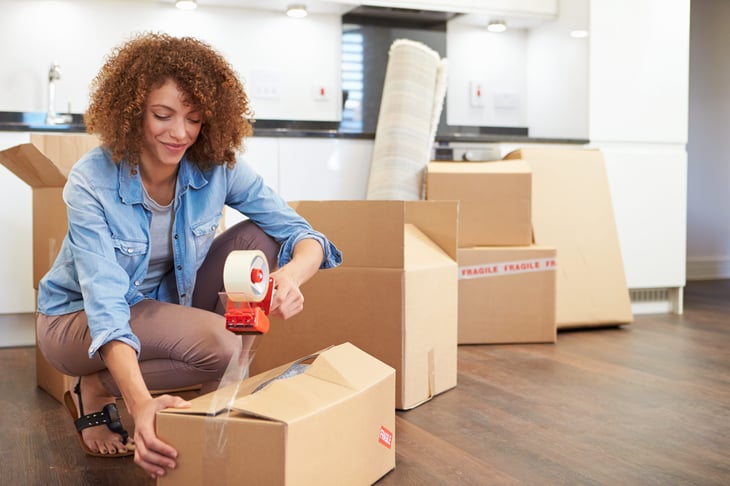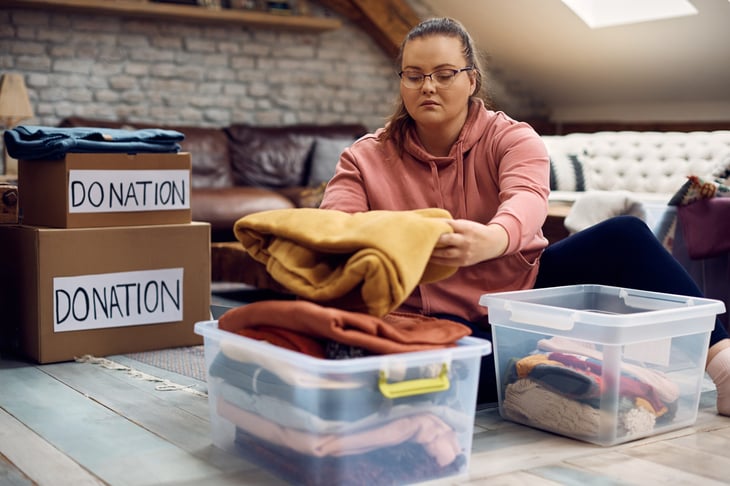
Editor's Note: This story originally appeared on Living on the Cheap.
Are you ready to downsize your home and save money? If so, you’ll need to decide which of your current belongings you’re going to keep and which need to go.
Even if you’re not planning on moving, decluttering can save you money by freeing up space and keeping you from buying more storage units. You might even make some money by selling your unwanted belongings.
It’s easy to talk about decluttering, and much harder to actually do it.
Downsizing expert Monica Friel, owner of Chaos to Order, gives us some tips and tricks to tackle the clutter situation.
Determine how much you need to downsize

Friel’s recommendation is to start by understanding how much stuff you have to get rid of.
If you are moving from 3,000 square feet to 1,000 square feet then you have to get rid of at least seven of every 10 items (or more) depending on the size of the items. This does not include furniture.
If you’re not moving, you can think about amounts in terms of a room, closet or chest of drawers you want to free up. Perhaps you need to get rid of a half closet’s worth of clothing or boxes.
Prioritize what you use

Next thing to do is determine what you actually use. We have all heard the rule that if you haven’t used it or thought about it for a year, get rid of it. This applies to everything including:
- Clothing. Go through your closets and examine item-by-item. Do you need 50 outfits, 30 pairs of shoes, 10 coats, etc.? What condition are some of these items in? Are there items you didn’t even know you had? If it’s too difficult to decide what you won’t use, choose the wardrobe pieces you wear all the time and get rid of the rest.
- Kitchen. Do you need 20 pots, six sheet trays, place settings for 24, etc.? Keeping this stuff around for the holidays doesn’t make sense. What do you need on a day-to-day basis?
- Books and magazines. Most books, newspapers and magazines can be accessed either online through the library or physically at the library. All the old investment, travel or other magazines you have accumulated are out-of-date anyway.
- Knickknacks, mementos. One suggestion about how to dispose of these types of items is to create a digital photo record and then get rid of them. You can look back at these items and remember them. You can also try to give them to relatives, so you can visit your mementos when you visit your family.
- Holiday decorations. Do you really need boxes and boxes of decorations for every holiday? As you get older you won’t want to (or shouldn’t be) climbing on your roof to put them up. Give the decor away, keeping only a few sentimental items or, better yet, pass those to your children.
- Childhood memories such as report cards, artwork, etc. If your kids are adults, let them decide if they want any of it. If they’re still young, winnow it down to one small shoe box per child. When they finally receive it years later, they probably won’t have any place to store several boxes of their childhood memories.
Stay motivated

This process won’t be easy.
The best way to motivate yourself to toss things is to ask yourself: Do I really want to pay a higher mortgage or rent every month for the rest of my life to keep things that I use once a year or that I never use at all?
Another way to think about the process: What would you replace if you lost everything in a fire or hurricane? This might be a great way to approach your decluttering.
Examine an item and decide whether you would really buy it again. If not, toss it.
Declutter one room at a time to see progress

As far as the mechanics of decluttering, you can take many different approaches. We like the room-by-room method because you can see the progress. Here’s how you do it:
- Start collecting empty boxes.
- Start in one room and create boxes for stuff you want to toss, donate, re-gift or sell.
- Throw out the first batch of items to be tossed that day. Try to recycle what you can according to your local rules. Once it’s gone, you can’t change your mind and get it back.
- Put the donate box in your car and drop it off as soon as possible to get it out of your house.
- If your friends and/or family want to take things, drive over to their homes and drop off the items as you go. If they live far away, then you need to arrange to ship the items or for them to pick them up in a timely fashion.
- Create a location in your house to store the items you plan to sell.
- Schedule a garage sale or get the items listed on eBay, Craigslist, Facebook Marketplace or your local Buy Nothing group.
- Save all the money you make from selling the clutter.
- Move on to the next room.
This may seem harsh, but if you don’t actually move stuff out of your home as you go, you are more likely to repatriate it back into your home.
And, according to Chaos to Order, nothing should be put in storage. Once it’s out of sight, it will just be another bill you are paying for stuff you will never use.
Don’t succumb to ‘Antiques Roadshow’ syndrome

Just because something is old doesn’t mean it’s worth anything or that it will ever be worth anything. I call this “Antiques Roadshow” syndrome.
For every person who finds a Jackson Pollock in their attic there are millions of people who have nothing of value piled up all over their homes.
Don’t spend time calling auctioneers or trying to determine if your old stuff is valuable. Unless you know it is, get rid of the unwanted items and move on.
Just throw it out

Even if some things have value, you simply don’t have time to organize a garage sale or sell everything online.
Don’t try to eke every penny out of the decluttering process; just donate to charity or throw the items out. If you do not get these things out of your home, you will never be able to downsize.
However, be careful not to dump items onto charities. Charities spend millions of dollars annually disposing of garbage that they cannot sell.
If the amount of stuff you have is overwhelming and you will not sell it and cannot donate it, get a dumpster and spend a day throwing everything away.
Think of it this way: Every month you procrastinate in getting rid of things prevents you from downsizing to a smaller home. If that is costing you $500 extra in rent or mortgage costs, then it’s not worth it to wait to sell things where you will only get pennies on the dollar.
Keep only the furniture that will fit

By the time you are getting rid of your furniture, you should know where you’re moving to and what will fit in the new location.
Measure repeatedly; there is no point in paying to move something that will not fit. That can be a disaster when you discover on move-in day that something won’t fit and you have to figure out how to get rid of it ASAP in a new location.
Additionally, do not buy anything before you move. Even if it is a once-in-a-lifetime sale, do not buy any new furniture until after you have moved.
When you are disposing of your existing furniture, keep in mind that used furniture is almost always nearly worthless (See “Antiques Roadshow” syndrome.) It doesn’t matter how much you paid for it originally, what brand it is or what condition it is in.
Furniture is like a car or a boat — it depreciates instantly. The day you “drive” it out of the showroom, it is worth a fraction of what you paid for it.
Save all the money you make from selling any excess furniture.
Hire a professional

If you cannot get the decluttering done yourself, seek professional help. Experts like Chaos to Order charge $80 or more per hour. This may seem expensive, but you should view it as an investment.
An expert can:
- expedite the process so you can declutter faster, move and start saving money sooner.
- help get you started and/or keep you on track.
- help you make decisions, organize a garage sale or hook you up with an eBay seller.
- get a photographer to take photos of your home as it was and create a Shutterfly or cloud-based “memory book.”
Helpful books on decluttering

Don’t buy these books; they’ll just add to your clutter. But if you’d like to read more about the art of decluttering, pick up a copy at your library or order one to your Kindle or e-reader.
- “The Gentle Art of Swedish Death Cleaning: How to Free Yourself and Your Family From a Lifetime of Clutter,” by Margareta Magnusson. This new book is focused on decluttering toward the end of life, but the techniques can (and should) be used at any age.
- “The Life-Changing Magic of Tidying Up: The Japanese Art of Decluttering and Organizing,” by Marie Kondo. Kondo advocates organizing by category rather than by room. And, she says, by organizing your space, you also create a more serene, less frenetic life.
- “Organizing From the Inside Out,” by Julie Morgenstern. This book, first published more than 20 years ago, has been updated with some tips on technology.
Bottom line

To sum up, if you want to improve your life, downsize your home and build wealth you need to:
- Collect empty boxes.
- Declutter all extraneous items room-by-room in order to make progress.
- Get rid of furniture.
- Move.
- Unpack.
- Assess your needs. Wait before you buy anything, including furniture. You will not perish if you don’t have a couch or dining room set for a month or two. Living in your space gives you time to assess what furniture you actually need and shop around for the best prices.
- Use the funds you raised from selling the excess clutter and furniture as your budget to buy (preferably used) furniture and any other items you need and have some place to store.
- Get out there and enjoy your new lower cost life.
Decluttering isn’t easy, but it’s rewarding and not just financially. Where I live many people have downsized from large suburban homes into condos that are 30% to 50% smaller than where they used to live.
No one has ever told me that they wished they hadn’t done it. Not only do you save money, but you have more time to enjoy your life because you have less things to take care of.
Keeping your new place clutter-free

How do you keep your new place (or newly emptied room) from amassing new clutter?
For decades, I have always employed a “nothing goes in unless something goes out” rule. Follow this rule, and you will always have the same number things and will never find yourself with any excess stuff. A place for everything and everything in it’s place.
Also, understand that a minimalist lifestyle is not common in the U.S. Case in point: A friend once told me about a family with several children who live in the smallest house in the neighborhood. What my friend found most appalling is how they “spend all this money taking trips and going to water parks and camping etc. when they live in the smallest house in the neighborhood!”
My response was: By not living in a giant house with a giant mortgage, they can actually afford to live and enjoy their lives by going out and doing things instead of paying for a home that’s bigger than they need. They’re the smartest people in the neighborhood. I would also bet that they have more money in the bank than their neighbors in the giant houses.
So prepare for people to not understand your motivation for downsizing. You are going against the tide. Ignore people who say “I could never live in something so small” or “a bigger home is a good investment.”
Just toss your stuff and prepare to live a whole new and much more enjoyable way of life.





Add a Comment
Our Policy: We welcome relevant and respectful comments in order to foster healthy and informative discussions. All other comments may be removed. Comments with links are automatically held for moderation.